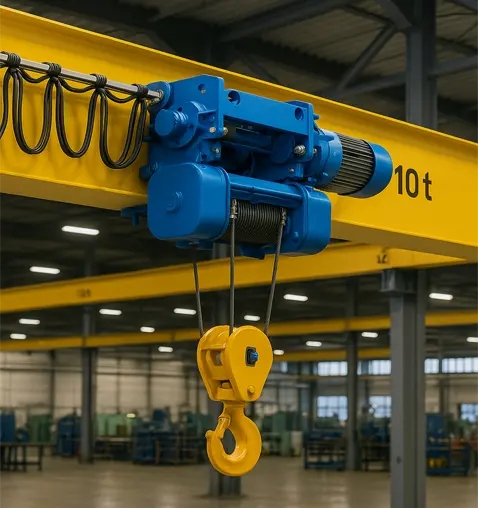What Is a Hoist Crane Mechanism?
A hoist crane is a heavy-duty lifting device used to raise loads by pulling or pushing them through a system of chains, cables, or steel ropes connected to a drive motor. An efficient hoist crane mechanism enables faster, safer, and more energy-saving operations. Hoists are commonly used in industries such as construction, warehousing, and manufacturing to move large and heavy objects with ease.
Main Components of a Hoist Crane System
To achieve optimal crane performance, understanding each component within the hoist system is essential. Every part plays a crucial role in maintaining the crane’s overall performance.
- Drive Motor: The motor is the heart of the hoist crane system, converting electrical energy into mechanical power to lift loads. Variable-speed or frequency-controlled motors allow more precise control over movement, reducing wear and improving durability.
- Lifting Chain or Wire Rope: This component is responsible for lifting the load. High-quality steel cables and durable lifting chains ensure strength and reliability. Keeping these components clean is essential to prevent premature wear.
- Electronic Control System: Automated control systems are key to ensuring precise and safe crane movements. With PLCs and inverters, operators can fine-tune speed smoothly, minimizing the risk of sudden or uncontrolled load movements.
- Crane Structural Design: This includes structural components such as trolleys and rails that support the hoist system. A strong yet lightweight design ensures smooth and efficient load movement.

Hoist Crane Mechanism
Key Factors for Efficient Hoist Crane Performance
The performance of a hoist crane is influenced by several technical and operational factors. Optimizing each element of the system leads to better performance, energy savings, and simpler maintenance.
- Speed and Accuracy Control: Crane speed can be adjusted using modern control systems such as VFDs (Variable Frequency Drives) or inverters, which regulate motor frequency to achieve precise movement and prevent shocks that could damage the load or crane.
- Use of Sensors and IoT Technology: Load sensors, position sensors, and IoT-based monitoring systems enable real-time tracking and early fault detection. These sensors help optimize operating speed and reduce potential damage.
- Load Capacity: A crane that is oversized for the load increases energy consumption, while an undersized crane risks failure. Matching the crane’s capacity to the load type and weight ensures maximum efficiency and safety.
The Importance of Maintenance for Sustaining Hoist Crane Performance
An efficient hoist crane system requires regular maintenance and periodic inspections to ensure all components function properly. Key maintenance steps include:
- Inspecting Cables and Chains: Regularly check for wear, damage, or overloading. Worn or frayed cables can lead to system failure.
- Cleaning and Lubricating Components: Clean parts such as rails, trolleys, and motors to prevent dust buildup that can accelerate wear. Proper lubrication reduces friction between moving parts.
- Replacing Damaged Components: Promptly replace worn or defective components to prevent further damage and ensure safe crane operation.
Advantages of Using an Efficient Hoist Crane
An efficient hoist crane system provides numerous benefits for industrial operations:
- Increased Productivity: Efficient hoist systems enable faster lifting cycles, enhancing crane uptime and overall productivity.
- Energy Savings: Variable-speed motors and automation systems reduce power consumption, lowering operational costs.
- Safety and Reliability: Advanced hoist cranes include safety features such as limit switches and load sensors to prevent overloading or operational errors.
- Lower Maintenance Costs: Well-maintained cranes experience fewer breakdowns and require fewer replacements, leading to reduced long-term maintenance expenses.
Conclusion
An efficient hoist crane mechanism not only enhances performance and productivity but also delivers additional benefits such as energy efficiency, improved safety, and lower operational costs. Through the application of modern technology, proper maintenance, and precise automation, companies can ensure that their hoist cranes operate optimally and deliver reliable performance for years to come.